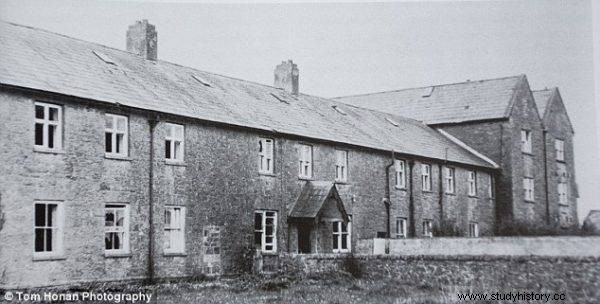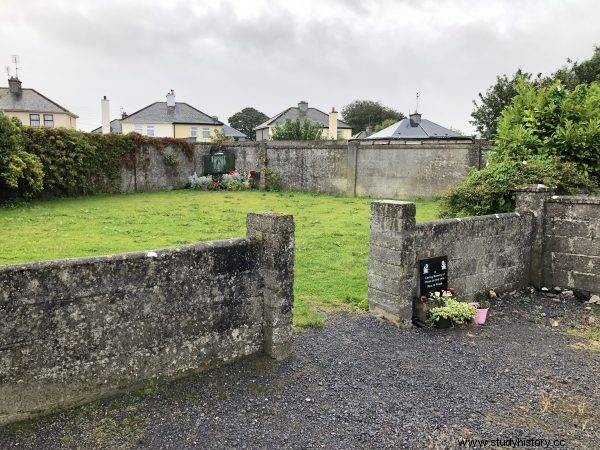Tuam is a small, quiet town in County Galway, in the northwest of Ireland. The number of its inhabitants does not exceed 9,000 people. This sleepy town, however, has a dark past. In 1975, on the site previously owned by the local Mother and Child Home, run by the sisters of the Bon Secour Congregation, two boys made a gruesome discovery.
Twelve-year-olds found a grave filled with children's remains in an unused underground water tank. The case, however ... did not arouse much interest. The corpse was believed to be victims of the Great Famine that hit Ireland in the 19th century. To ensure the peace of the dead, the priest said a prayer and the tomb was closed again. It took 37 years for the truth about the mass grave to see the light of day.
In 2012, in the Journal of the Old Tuam Society, local historian Catherine Corless published an article that attracted the attention of the national and international press - and the Irish government. The woman revealed the result of an investigation she had conducted on her own (and with private funds). It concerned the resting place of 796 children. They were the charges of the Mother and Child Home in Tuam.
Corless compared the death certificates issued by the care facility with the records of burials in local cemeteries. She only found two graves. The resting places of almost 800 toddlers were still unknown. Then she remembered the mass grave in the land that the order had sold to the developer, and where an estate of detached houses and a playground were built.
Home (not for) Mother and Child
The facility in Tuam offered help to women in illegitimate pregnancies. Run from 1925 to 1961, it was one of the many government-funded centers in Ireland managed by Catholic institutions. Children born in these homes were usually put up for adoption, although this did not always happen immediately. In many cases, it took years for the little ones to find their way into new families.
These were times when pregnant women were excluded from society. They were considered disgraced regardless of the circumstances in which they conceived. In Catholic Ireland, very often a girl who was in a different state and had no husband had nothing to say about her situation. It was the family, often with the support of local church authorities, that made decisions for it. This was the case with the mother of P.J. Haverti, one of the former charges of the Tuam Mother and Child Home.

In the memories of the former residents, the facility appeared to be a very harsh place, devoid of love, joy and any other warm feelings.
She came under the care of the Bon Secour sisters thanks to her parents and a priest from her parish. At the center, she gave birth to a son who was taken from her (against her will). She was sent home as soon as it became possible. However, the young mother was not going to give up easily and visited the facility regularly, demanding to see the boy.
To put an end to these visits, the nuns informed her of the adoption. The woman, unable to cope with the trauma, left for England, where she began a new life. She got married and had children. She hid the story of her first pregnancy from the world. After many years, P.J. Haverty decided to find his mother himself, thanks to which she had the opportunity to meet her firstborn son and establish a relationship with him before her death. It turned out that nuns lied to her. The boy stayed with them until he was 7 - and he did not remember it happily .
Eventually, fate smiled at him. However, not all those under the care of the Mother and Child Home in Tuam were so lucky. Some of them never left the walls of the center…
Sad truth
In the memories of the former residents, the facility appeared to be a very harsh place, devoid of love, joy and any other warm feelings. The housing conditions were also not impressive. One of the reports prepared during the operation of the center indicated that it was overcrowded. This again led to an inability to provide the charges with adequate healthcare or nutrition.
In the death records disclosed by Catherine Corless, you can find out about the causes of the death of the children. He appears there, among others flu, pneumonia, malnutrition, epilepsy, measles and whooping cough. These were not incurable diseases and probably proper medical care and diet would have saved some of the babies.

In March 2017, it was confirmed that a significant proportion of the bodies in the grave are those of children from a few weeks to several years old.
The high mortality rate of the charges of the Tuam center is also visible in reports prepared by state inspectors at the time when the institution was operating. However, despite the apparent evidence of child malnutrition and an overcrowding of the House, the nuns were not considered to be at fault. Their work was judged to be good and the reasons for the excess deaths were recommended to be looked for elsewhere.
Surprisingly, there were also no doubts about the adoptions carried out by the institution at that time. Children from the Tuam Mother and Child Home were taken in not only by Irish families, but also sent to the USA, where they were handed over to Catholic couples. In many cases, it happened illegally, after the payment of the appropriate fee by the future parents. To this day, the names of children adopted in this way are unknown. Their files were probably classified by the Church or destroyed.
The Catherine Corless investigation eventually forced Irish authorities to investigate the remains of a mass grave in Tuam. In March 2017, it was confirmed that a significant proportion of the bodies in the grave are those of children from a few weeks to several years of age and they come from the time when the Home for Mother and Child was in operation.
Calculations show that on average one child died in the center every two weeks. Unfortunately, the statistics do not reflect the true extent of this tragedy, the causes of which are believed to be both government and church negligence.
